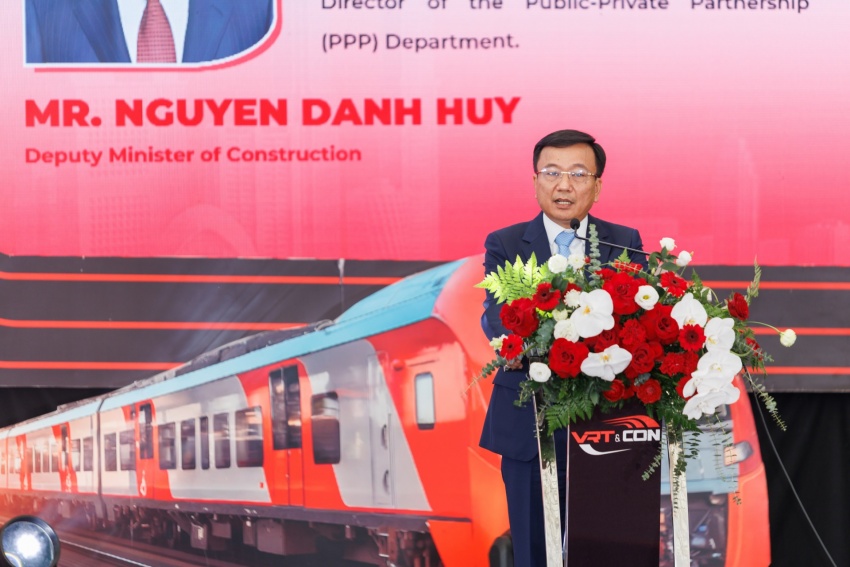The International Exhibition and Conference on Modern Railway Technology and Infrastructure Construction Supply Chain in Vietnam (VRT&CONS) 2025 took place at the Vietnam Exposition Centre in Hanoi on November 12, bringing together key stakeholders from across the global rail industry.
The event was held under the direction of the Ministry of Construction and chaired by the Vietnam Railway Authority, in coordination with the Railway Project Management Unit, the Open Innovation and Tech Entrepreneurs Institute, HTECH Technology and Engineering JSC, Bach Dang One-Member Company, and Camel Exhibition and Trade Promotion Company.
As the first international exhibition and conference in Vietnam dedicated to the railway and infrastructure sectors, VRT&CONS 2025 is positioned as a strategic dialogue platform and long-term investment networking hub for Vietnam’s emerging railway industry ecosystem.
“We are standing at a historic opportunity to reshape the landscape of Vietnam’s railway sector. However, it must be acknowledged that this is a highly specialised industry requiring enormous capital investment, complex technology, lengthy implementation time, and robust management mechanisms,” said Nguyen Danh Huy, Deputy Minister of Construction.
 |
| Nguyen Danh Huy, Deputy Minister of Construction |
He pointed out that Vietnam’s railway sector still faces multiple challenges such as limited transport market share, outdated technology, fragmented infrastructure, and, most importantly, the absence of a domestic industrial ecosystem.
“These issues can only be removed through new thinking, new approaches, and comprehensive cooperation,” he continued. “Within the overall infrastructure landscape, the railway system is identified as the backbone of the national transport network. Developing railways, particularly high-speed and urban lines, is a new growth driver that will help restructure the economy, optimise logistics costs, reduce greenhouse gas emissions, strengthen regional connectivity, and advance international integration while ensuring national defence and security.”
In his remarks, Huy outlined several key objectives for the development of Vietnam’s railway industry.
“First, technological connectivity. Vietnam is not seeking the most expensive technologies, but the most suitable ones,” he said. “Second is solution connectivity. Rather than simply purchasing trains or building lines, Vietnam aims for integrated solutions encompassing investment models, smart operation management, and maintenance systems.”
The third suggestion offered by Huy was investment connectivity. Given the vast funding requirements, the government cannot rely solely on the state budget.
“Vietnam is committed to creating transparent, breakthrough mechanisms to attract private and foreign investment. We call on financial institutions, investment funds, and major corporations to collaborate and propose practical, effective financial models,” Huy said.
Fourth, supply chain connectivity. This, he emphasised, is the key to sustainable development.
“Vietnam must build its own railway industrial ecosystem, and international engineering, procurement, and construction contractors and corporations investing in Vietnam should bring Vietnamese enterprises into their value chains through technology transfer and capacity building, enabling deeper participation in global supply networks,” he added.
Speaking at the exhibition, German Ambassador to Vietnam Helga Margarete Barth said, "Germany has a history of developing modern railways, both in terms of track technology and maintenance and operation. Germany is ready to share experiences and cooperate with Vietnam in building modern railways, meeting the needs of regional connectivity, green transformation, and economic development."
 |
| German Ambassador to Vietnam Helga Margarete Barth |
From the business side, Railway Transport JSC (TRV) identified the railway information and signalling sector as its strategic development focus for 2025-2030. The company aims to master core technologies, gradually localise production, and deploy modern monitoring and control systems in line with international standards.
“With a shared commitment to supporting the government’s national transport modernisation agenda, TRV respectfully proposes that the government and relevant ministries continue to provide support in two key areas,” said Tran Thi Hue Chi, chairwoman of TRV Vietnam.
“First, to develop policies that encourage the socialisation of investment in railway infrastructure and industry, particularly in signalling technology and green logistics. Second, to create favourable conditions for domestic enterprises to participate more deeply in pilot projects, technology transfer, and equipment production, thereby gradually mastering the value chain of the Vietnamese railway industry under the made in Vietnam brand,” she added.
VRT&CONS 2025 is running from November 12-15, featuring two main pillars: an industrial exhibition showcasing products, equipment, and technologies in the railway sector, and a conference series that includes strategic dialogues, high-level forums, CEO roundtables, investment connection sessions, technical solution presentations, career talks, and a railway technology experience day.
Alongside the main exhibition, an investment and partnership hub is open throughout the four-day event, offering a dedicated business-to-business meeting space for enterprises, financial institutions, investment funds, industrial zones, and solution providers.
During the event, numerous MoUs were signed between Vietnamese enterprises and international partners, witnessed by representatives of ministries, embassies, and international organisations, signalling a strong step forward for Vietnam’s modern railway industry.
 |
| Overview of VRT&CONS 2025 |




















































